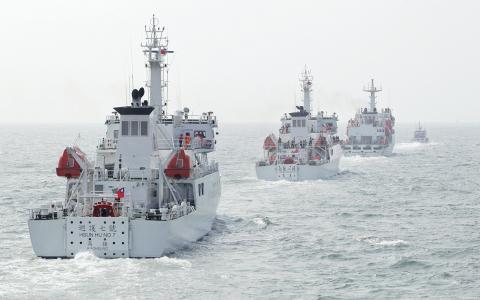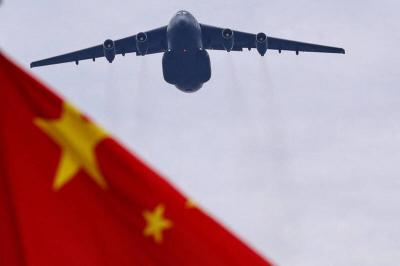The nation is building a US$100 million port next to an airstrip on the lone island it occupies in the disputed South China Sea, a move that is drawing hardly any flak from the most assertive player in the bitterly contested waters — China, military strategists said.
The reason is that Itu Aba (Taiping Island, 太平島) could one day be in China’s hands, should it ever take over Taiwan, they said.
While Itu Aba is small, no other disputed island has such sophisticated facilities. Its runway is the biggest of only two in the Spratly archipelago (Nansha Islands, 南沙群島) that straddles the South China Sea, and the island has its own fresh water source.

Photo: PICHI CHUANG, Reuters
“Taipei knows it is the only claimant that [China] will not bother, so it is free to upgrade its facilities on Taiping, without fear of criticism from China,” said Denny Roy, a senior fellow at the Hawaii-based East-West Center think tank. “China would protect Taiwan’s garrisons if necessary.”
The upgraded facilities on Itu Aba should be finished late next year or earlier, officials from the Ministry of National Defense and Ministry of Transportation and Communications said, replacing an existing wharf that can only handle small vessels.
The upgrade would give Taiwan a port able to accommodate 3,000 tonne naval frigates and coast guard cutters, while improvements are being made to the 1,200m runway for its Hercules C-130 transport planes, the officials said.
They said the new port was not just a demonstration of sovereignty, but also a way to support a trade-dependent economy, while helping the nation’s deep-sea fishermen and marine and mineral carry out research in the area.
About US$5 trillion in ship-borne goods pass through the South China Sea every year.
Taiwan and China share claims to virtually the entire South China Sea. Vietnam, the Philippines, Malaysia and Brunei also claim parts of the potentially oil-rich sea.
While Taiwan-China ties have warmed since President Ma Ying-jeou (馬英九) came to power in 2008, there has been no political reconciliation or a lessening of military distrust.
However, if conflict ever broke out in the Spratlys, analysts and military experts believe China would seek to protect Itu Aba as its own, strongly aware of its strategic value.
The Spratlys are one of the main flashpoints in the South China Sea, where military fortifications belonging to all claimants, except Brunei, are dotted across some of the world’s busiest shipping lanes.
China occupies eight shoals and reefs, but its strategists have long bristled at Vietnam’s two dozen holdings. Manila occupies eight reefs and islands, and Malaysia seven.
Incidents at sea in recent years, such as ships getting rammed or attempted blockades, have usually involved China against the Philippines or Vietnam.
Zhang Zhexin (張哲馨), a research fellow on Taiwan issues at the Shanghai Institute for International Studies, said Beijing would not have a problem with the nation developing Itu Aba.
“Taiwan itself is Chinese territory anyway,” he said.
“How can we have a territorial dispute within our own country? Of course Taiwan is part of China, so that includes all parts of China, including Taiping Island,” he said.
The island, administered by the Coast Guard Administration, is about 1,600km southwest of Taiwan, out of range of its US-made F-16 warplanes, lying between the Philippines, Vietnam and Malaysia.
Unlike Beijing, Taipei is low-key about asserting its claims in the South China Sea and does not deploy naval or civilian fleets to the outer limits of the so-called nine-dash line that Beijing displays on its official maps and which reaches deep into maritime Southeast Asia, strategists say.
The nation has not trumpeted its upgrade to Itu Aba.
“We would never invade islands occupied by other nations, but we will actively defend our claims,” said a spokesman for Chinese Nationalist Party (KMT) Legislator Lin Yu-fang (林郁方), a key backer of the port project.
The facility would provide services to any Taiwanese ships in the region, said Chen I-piao, acting chief engineer at the Taiwan Area National Expressway Administration Bureau, the unit responsible for building the wharf.
“Previously our vessels in the area had to liaise with other ships if they needed assistance. After the port is finished they’ll be able to directly call at port,” Chen said.
Scores of Vietnamese and Chinese ships continue to square off around the rig, placed between the Paracel Islands (Xisha Islands, 西沙群島) occupied by China and the Vietnamese coast guard.
While Vietnam and the Philippines have protested plans by Taiwan to upgrade the wharf, the construction is generating much less heat than Beijing’s muscle-flexing in the South China Sea.
Days after China deployed the oil rig to the Paracel chain, the Philippines accused Beijing of reclaiming land on a disputed reef in the Spratlys to build what would be its first airstrip in the South China Sea.
China has rejected a Philippine protest over the air strip construction on Johnson South Reef (Chigua Reef, 赤瓜礁), saying it has the right to develop its territory.
Experts say any airstrip there would unlikely be a strategic game-changer because of the difficulty in building a workable runway on an atoll, unlike an island like Itu Aba.
And as Itu Aba is the largest island in the Spratlys and the only one with natural water supplies, legal experts say this could help any future formal claim to a 200 nautical mile (370km) exclusive economic zone and any fish and oil within it.
The nation has not cooperated with China on the South China Sea, despite the historical ties to each other’s claims, given the political mistrust between them, but also because of the nation’s need to maintain good relations with the US, said a vocal critic of Beijing’s policies in the disputed waters, experts say.
For the most part, Taiwan has kept its head down, not wanting to upset China or claimants in Southeast Asia given its economic links to all, strategists say.
At various times, the nation has pushed to be involved in regional mechanisms to easing tensions, but resistance from China means it plays no part in any efforts through ASEAN, they said.
“I think the major concern is US-Taiwan relations. The US government asked Taiwan not to move close to China on the South China Sea,” said Song Yann-huei (宋燕輝), a South China Sea expert at Academia Sinica.

Beijing could eventually see a full amphibious invasion of Taiwan as the only "prudent" way to bring about unification, the US Department of Defense said in a newly released annual report to Congress. The Pentagon's "Annual Report to Congress: Military and Security Developments Involving the People's Republic of China 2025," was in many ways similar to last year’s report but reorganized the analysis of the options China has to take over Taiwan. Generally, according to the report, Chinese leaders view the People's Liberation Army's (PLA) capabilities for a Taiwan campaign as improving, but they remain uncertain about its readiness to successfully seize

Taiwan is getting a day off on Christmas for the first time in 25 years. The change comes after opposition parties passed a law earlier this year to add or restore five public holidays, including Constitution Day, which falls on today, Dec. 25. The day marks the 1947 adoption of the constitution of the Republic of China, as the government in Taipei is formally known. Back then the Chinese Nationalist Party (KMT) governed China from Nanjing. When the KMT, now an opposition party in Taiwan, passed the legislation on holidays, it said that they would help “commemorate the history of national development.” That

Taiwan has overtaken South Korea this year in per capita income for the first time in 23 years, IMF data showed. Per capita income is a nation’s GDP divided by the total population, used to compare average wealth levels across countries. Taiwan also beat Japan this year on per capita income, after surpassing it for the first time last year, US magazine Newsweek reported yesterday. Across Asia, Taiwan ranked fourth for per capita income at US$37,827 this year due to sustained economic growth, the report said. In the top three spots were Singapore, Macau and Hong Kong, it said. South

Snow fell on Yushan (Jade Mountain, 玉山) yesterday morning as a continental cold air mass sent temperatures below freezing on Taiwan’s tallest peak, the Central Weather Administration (CWA) said. Snowflakes were seen on Yushan’s north peak from 6:28am to 6:38am, but they did not fully cover the ground and no accumulation was recorded, the CWA said. As of 7:42am, the lowest temperature recorded across Taiwan was minus-5.5°C at Yushan’s Fengkou observatory and minus-4.7°C at the Yushan observatory, CWA data showed. On Hehuanshan (合歡山) in Nantou County, a low of 1.3°C was recorded at 6:39pm, when ice pellets fell at Songsyue Lodge (松雪樓), a